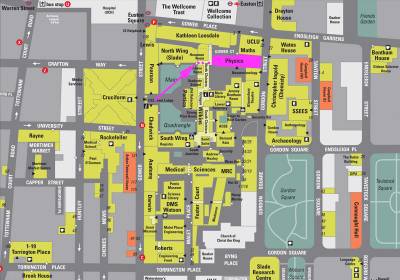HOME | MEMBERS | RESEARCH | PUBLICATIONS | LINKS |
About Me
I completed my undergraduate degree in Chemistry at Queen Mary, University of London, graduating with a MSci in 2019. I took an interest in molecular modelling in my third year of undergraduate while completing my literature review in computational modelling of photochemical reactions with Dr Rachel Crespo-Otero.
Initially I took an experimental route for my final year masters project by joining the research group of Prof. A. Vleck researching the potential of future metal complexes for protein sensitisation focusing on rhenium-centred diimine complexes. However, I decided to further develop my training in molecular modelling.
I completed a MRes Molecular Modelling & Materials science, as part of the Molecular Modelling and Materials Simulation (M3S) Centre for Doctoral Training (CDT) in the chemistry department at UCL in September 2019 where I joined the research group of Prof. Scott Woodley which involved the testing of new interatomic potentials used in probing the energy landscape of titanium oxide nanoclusters. This included the testing the effectiveness of the Charged Optimised Many Body Potentials (COMB3) with increasing titania cluster size.
After completing my masters, I transitioned from Chemistry to Physics by joining the Shluger group in September 2020 working in the Condensed Matter and Materials Physics group within the Department of Physics and Astronomy which focuses on modelling the effects of defects in materials on the performance and reliability of nano-electronic devices.
Research
Background
The group has been involved in developing models of reliability of MOSFETs and mechanisms of resistive switching for the last 20 years. It is employing state of the art computational methods to study defects in crystalline and amorphous gate oxides and at interfaces with Si and metal electrodes. It was one of the first to propose models of intrinsic as well as N related defects in HfO2[1,2], hydrogen related defects responsible for NBTI of SiO2 based devices [3] and multi-scale models of dielectric breakdown in SiO2 based devices [4]. For the last 20 years the group has been studying defects in amorphous SiO2, HfO2, Al2O3 and other gate oxides in relation to reliability and dielectric breakdown of devices and resistive switching [5]. It created some of the first models of Si/SiO2/HfO2 interfaces [5] (right) and SiO2/TiN interfaces [6] and investigated properties of defects at these interfaces.
The PhD project is a natural development of this work towards better understanding of performance a reliability issues in more sophisticated modern devices. It will be carried out in collaboration with the experimental group of Prof. Souvik Mahapatra at IIT Bombay which has wide connections with industrial partners, and will use and help to develop further the computational tools developed at QuantumATK and Synopsys inc.
We propose to model the structure and defect processes in the gate stacks for modern devices,
which include Si (channel, 100 and 110 orientations) / IL (SiO2/SiON) / HfSiO (N) / HfO2 / TiN
(amorphous) layers and investigate defect processes responsible for the performance and reliability
issues in pertaining devices. We will mainly use the QuantumATK code for the simulations but also
for reference calculations use the LAMMPS and CP2K codes to validate the QuantumATK codes.
The research will be carried out on two main themes:
Modelling the structure and electronic structure of Si|(SiO2/SiON)|HfSiO (N)|HfO|TiN stacks
This work will focus on modelling the density and properties of chemical SiO2 interface layer before and after nitridation in
comparison with thermally grown SiO<sub>2</sub> layers, and modelling the amorphous TiN layer. For
constructing these layers we will test and apply the molecular dynamics tools and forcefields
available in QuantumATK. The results will include the structure of interfaces, band offsets and
band bending effects due to interface dipoles. Constructing these stacks will allow us to consider the
effects of impurities, such as La, Al, Co, Ta, Mg on the electronic structure of compounded gate
stack and work-function engineering. The work will help develop effective protocols for
QuantumATK to setup these systems and market the tools through scientific publications.
Reliability
The primary goal will be to find out precursors (for trap generation) and traps
(process related) that are responsible for defect generation and trapping respectively. We will focus
on intrinsic defects, such as O vacancies in SiON and HfON and hydrogen related defects and
intrinsic electron and hole trapping in amorphous films [7]. The results will include:
i. Trap energy location and formation energy.
ii. Nature of traps - donor / acceptor that are responsible for n and p channel FETs.
iii. Nature of traps that are triggered during BTI, HCI and TDDB stress.
To link with experimental measurements we will use NEGF tools available in QuantumATK. The
calculated values for defects will be used in Sentaurus Device for reliability modelling.
Industry collaborators
The work in the PhD will couple QuantumATK with Sentaurus for relevant industrial problems.
The work will help identify new SMW modules. Prof. Mahapatra and Prof. Shluger has a close
relation with the industry, and a deep understanding of structural and process related problems for
current and upcoming technologies, thus, their input will be an important contribution for
developing and marketing QuantumATK.
References
Publications
[1] A. S. Foster, F. Lopez Gejo, A. L. Shluger, R. M. Nieminen, Vacancy and interstitial defects in hafnia, Phys. Rev. B 65, 174117 (2002)
[2] J. L. Gavartin, A. L. Shluger, A. S. Foster, G. Bersuker, The role of nitrogen-related defects in high- dielectric oxides: Density-functional studies, J. Appl. Phys. 97, 053704 (2005)
[3] Y. Wimmer, Al-M. El-Sayed, W. Gos, T. Grasser, A. L Shluger, Role of hydrogen in volatile behaviour of defects in SiO<sub>2</sub>-based electronic devices, Proc. Roy. Soc. A 472, 20160009 (2016)
[4] A. Padovani, D. Z. Gao, A. L. Shluger, L. Larcher, A microscopic mechanism of dielectric breakdown in SiO<sub>2</sub> films: An insight from multi-scale modelling, J. Appl. Phys. 121, 155101 (2017)
[5] J. L. Gavartin and A. L. Shluger, Modeling HfO<sub>2</sub>/SiO<sub>2</sub>/Si interface, Microel. Eng. 84, 2412 (2007)
[6] J. Cottom, et al., Modeling of Diffusion and Incorporation of Interstitial Oxygen Ions at the TiN/SiO2 Interface, ACS Applied Materials & Interfaces, 11, 36223 (2019)
[7] J. Strand, M. Kaviani, D. Gao, Al-M. El-Sayed, V.V. Afanas ev, A. L. Shluger, Intrinsic charge trapping in amorphous oxide films: status and challenges, 30, 233001 (2018)
 Close
Close







